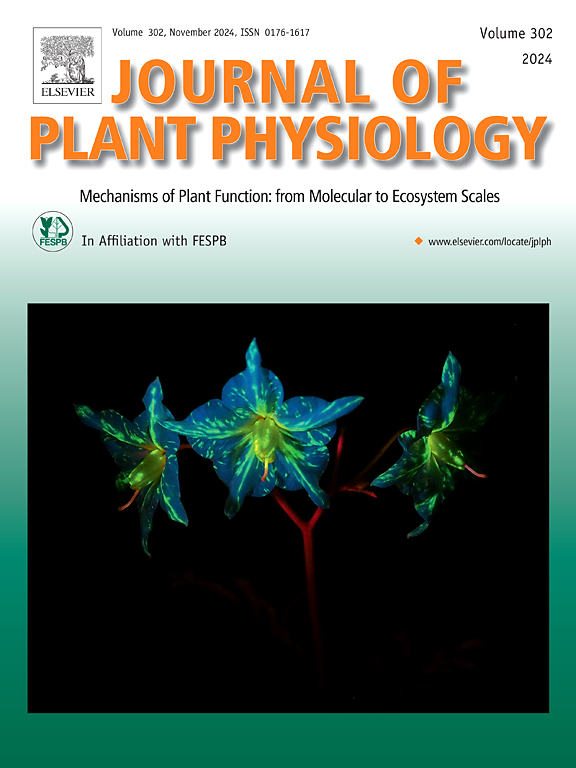Dual role of cytosolic GSH in the ABA signaling pathway and plasma membrane ion channel regulation in guard cells of Vicia faba
IF 4
3区 生物学
Q1 PLANT SCIENCES
引用次数: 0
Abstract
Abscisic acid (ABA) induces stomatal closure in higher plants under drought stress. Glutathione (GSH) negatively regulates ABA-induced stomatal closure and reactive carbonyl species (RCS) play a role as signal mediators downstream of reactive oxygen species production in ABA signaling pathway in Arabidopsis thaliana. Activation of slow (S-type) anion channels and inhibition of inward-rectifying potassium ion (Kin+) channels in the plasma membrane are essential for ABA-induced stomatal closure. However, there is limited evidence regarding role of GSH in the activation of S-type anion channels and the inhibition of Kin+ channels. We used Vicia faba to clarify the regulation of these ion channels by GSH and RCS. Pretreatment of guard-cell protoplasts with the GSH-supplementing agent, glutathione monoethyl ester (GSHmee), suppressed the activation of S-type anion channels and the inactivation of Kin+ channels induced by ABA. The pretreatment with the RCS scavenger carnosine suppressed the activation of S-type anion channels and the inactivation of Kin+ channels by ABA. On patch clamping guard-cell protoplasts, the addition of GSH to the pipette (cytosolic) buffer decreased the S-type anion currents and increased the Kin+ currents. These results suggest that cytosolic GSH is involved in ABA-induced stomatal closure via negative regulation of ABA signaling and via direct regulation of ion channel activities in V. faba.
胞质谷胱甘肽在蚕豆保护细胞ABA信号通路和质膜离子通道调控中的双重作用
干旱胁迫下,脱落酸(ABA)诱导高等植物气孔关闭。在拟南芥ABA信号通路中,谷胱甘肽(GSH)负调控ABA诱导的气孔关闭,活性羰基物质(RCS)作为活性氧产生下游的信号介质发挥作用。aba诱导的气孔关闭需要激活质膜中缓慢(s型)阴离子通道和抑制向内整流的钾离子(Kin+)通道。然而,关于谷胱甘肽在激活s型阴离子通道和抑制Kin+通道中的作用的证据有限。以蚕豆为研究对象,阐明GSH和RCS对这些离子通道的调控作用。gsh补充剂谷胱甘肽单乙酯(GSHmee)预处理保护细胞原生质体,抑制了ABA诱导的s型阴离子通道的激活和Kin+通道的失活。RCS清除剂肌肽预处理抑制了s型阴离子通道的激活和ABA对Kin+通道的失活。在膜片夹持保护细胞原生质体中,向移液管(细胞质)缓冲液中添加谷胱甘肽可降低s型阴离子电流,增加Kin+电流。这些结果表明,胞质谷胱甘肽通过ABA信号的负调控和直接调控蚕豆中离子通道的活性参与了ABA诱导的气孔关闭。
本文章由计算机程序翻译,如有差异,请以英文原文为准。
求助全文
约1分钟内获得全文
求助全文
来源期刊

Journal of plant physiology
生物-植物科学
CiteScore
7.20
自引率
4.70%
发文量
196
审稿时长
32 days
期刊介绍:
The Journal of Plant Physiology is a broad-spectrum journal that welcomes high-quality submissions in all major areas of plant physiology, including plant biochemistry, functional biotechnology, computational and synthetic plant biology, growth and development, photosynthesis and respiration, transport and translocation, plant-microbe interactions, biotic and abiotic stress. Studies are welcome at all levels of integration ranging from molecules and cells to organisms and their environments and are expected to use state-of-the-art methodologies. Pure gene expression studies are not within the focus of our journal. To be considered for publication, papers must significantly contribute to the mechanistic understanding of physiological processes, and not be merely descriptive, or confirmatory of previous results. We encourage the submission of papers that explore the physiology of non-model as well as accepted model species and those that bridge basic and applied research. For instance, studies on agricultural plants that show new physiological mechanisms to improve agricultural efficiency are welcome. Studies performed under uncontrolled situations (e.g. field conditions) not providing mechanistic insight will not be considered for publication.
The Journal of Plant Physiology publishes several types of articles: Original Research Articles, Reviews, Perspectives Articles, and Short Communications. Reviews and Perspectives will be solicited by the Editors; unsolicited reviews are also welcome but only from authors with a strong track record in the field of the review. Original research papers comprise the majority of published contributions.
 求助内容:
求助内容: 应助结果提醒方式:
应助结果提醒方式:


